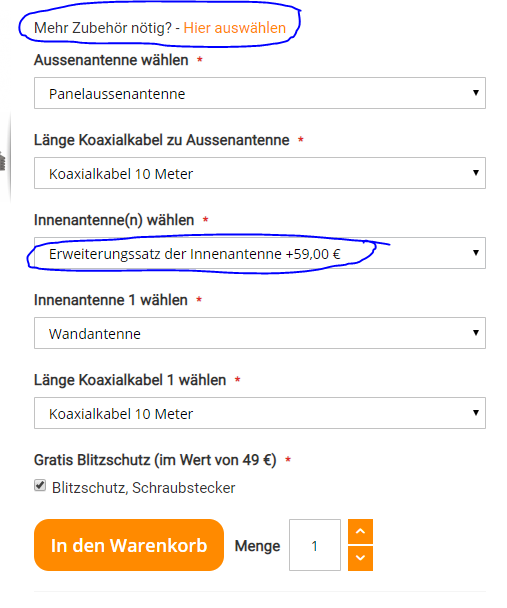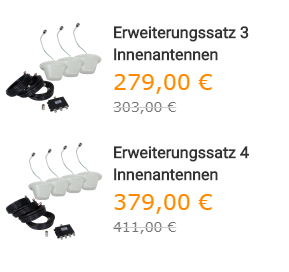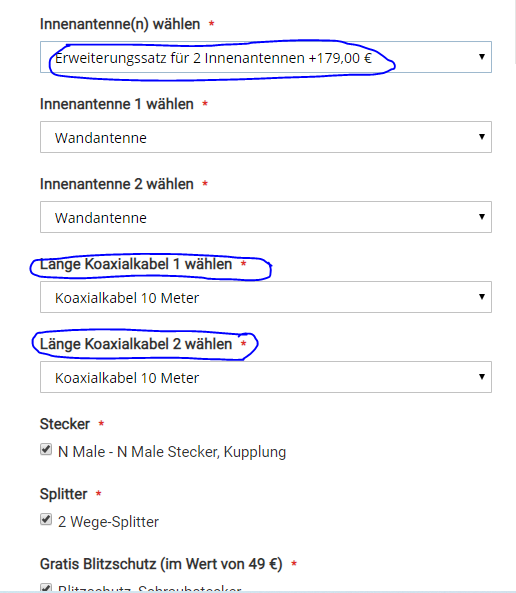
Each 4G signal amplifier contains a kit that allows it to function: in addition to the amplifier/repeater, it contains an outdoor antenna, a coaxial cable, and an indoor antenna. But what if, because of more floors to cover, you need more indoor antennas? How do you proceed?
This is a perfectly legitimate question that we hear regularly on the phone. On the one hand, it is necessary to determine whether the desired 4g signal amplifier holds more than one antenna (it must have a power of at least 13 dBm). In addition, connecting multiple antennas requires several elements (couplers, splitters, connectors, cables...) found in our catalog.
That is why we have already put together several extension sets, so that it is as easy as possible to customize the set of cell phone signal amplifiers/repeaters. So you will not forget anything.
- What is a 4G signal amplifier extension set?
- Choose the right extension set for your indoor environment
- How many indoor antennas are needed?
- Choose the type of antenna
- The length of the coaxial cable for each antenna
- Other things to consider
1.What is a 4G signal amplifier extension set?
If you need more than one antenna for your 4G signal amplifier to cover the entire room, an extension set simplifies the choice and is designed to replace the indoor antenna provided in the standard kit. The price is of course appropriate-it is cheaper than buying the products separately.
1.1 A complete set
An extension set contains everything needed to connect multiple indoor antennas to the cellular signal amplifier. An extension set with 2 indoor antennas contains, for example:
1x N-Male-N-Male (NM-NM) connector for connecting the splitter to the amplifier
2x 10-meter Coaxial cables
2x Indoor panel or ceiling antennas
You can choose the lengths of coaxial cables or the type of indoor antenna exactly according to your needs! In the case of an extension cable for the indoor antenna, one cable (optional length: 10 m, 15 m, 20 m or 30 m) is provided for each individual indoor antenna. One end is connected to the connector marked 'INDOOR' on the cell phone signal repeater, while the other end is connected to the indoor antenna. Again, you have the choice: choose between a panel, ceiling, or slim ceiling antenna, depending on your needs or on-site installation options. All indoor antennas are compatible with 3G and 4G GSM networks.
1.2 A simple installation
1.3 Replacement of standard indoor antenna
Each of our extension sets can be regarded as a "variant" of our cellular signal amplifier kits. In other words, when you buy the extension set, you no longer need the standard indoor antenna. It is replaced by the extension set and the price of the latter is adjusted.
2.Choose the right extension set for your indoor environment
Depending on the configuration of your premises, including the number of floors, the number of indoor antennas needed to achieve good coverage is first defined. Then the most congenial type of each indoor antenna (panel or ceiling) is chosen and the length of coaxial cable connecting each antenna is estimated.
2.1 How many indoor antennas are needed?
Defining the number of antennas needed for a 4G signal amplifier is very simple, you apply some basic principles and it is nothing complicated (1 indoor antenna per 250/300sqm). If you think you need more than 4 indoor antennas, please contact us for further assistance. Our team will analyze your situation in detail and provide you with a complete analysis of your needs.
2.2 Choose the type of antenna
Do your premises have suspended ceilings? If so, use ceiling antennas. They are installed in the center of the room to be covered and are the easiest and fastest solution for installation. The result is perfect, as the antenna radiates 360°. We have two models available, the features of which differ mainly in aesthetics. The ceiling antenna (with dome) is very classic and very effective. The slim ceiling antenna, on the other hand, is ultra-flat, more discreet and in line with the trend of modern office design and layout. Without a false ceiling or for rooms with very high ceilings? In these cases, the panel antenna (small flat screen) is perfectly adapted to your needs. Thanks to the included mounting plate, installation is easy; the cable can be laid "above ground" and routed, for example, along ceiling battens or in suspended ducts.
2.3 The length of the coaxial cable for each antenna
Select the desired length for each of the coaxial cables from the drop-down menu on the repeater page:
3.Other things to consider
3.1 Choose the 4G signal amplifier power according to the number of indoor antennas
Select the power of the cellular signal amplifier according to the number of indoor antennas. Depending on the number of indoor antennas, the device with the right power is chosen. This will ensure that each of the indoor antennas receives enough power to provide the intended coverage. Let's make a comparison: in a house the electrical supply has a certain power, which corresponds to the typical requirement in that type of environment. Now imagine that all the houses in the neighborhood are connected to your switch. Very quickly the switch "blows" because it does not have enough power for everyone. Well, it is almost the same for cell phone signal amplifiers: if the power distributed to each antenna is insufficient, it cannot work properly and its distribution is reduced to almost zero. Therefore, depending on the number of antennas inside your installation, you need to choose the power accordingly.
3.2 Consider the signal loss due to the length of the coaxial cable
There is a natural phenomenon in radio electricity, loss: waves lose their energy with distance. You know this phenomenon, especially in a car: you listen to your favorite FM transmitter, and after a few kilometers the signal unfortunately disappears--and listening becomes impossible. The same phenomenon occurs when the signal is transmitted through a cable. This is called cable loss and must be included in the estimation of the signal amplifier power of the cell phone connected to multiple antennas. Consider 1 dB for each additional 10 m of cable as an average value. Thus, for a 20 m cable, count 2 dB of loss. For a 30 m cable, consider 3 dB attenuation. Then add up all the loss values. If the sum is 3 dB or less, take the power just above the recommended power for your number of antennas in the following table. If the sum is 5 dB or less, take the even higher power.
3.3 Summary table
|
Number of internal Antennas |
Cellular signal amplifier power
|
|
|
|
|
1 |
10 dBm |
|
2 |
13 dBm |
|
3 |
15 dBm |
|
4-8 |
20 dBm |
|
8-12 |
23 dBm |
Problems calling from the workplace because of wall insulation? No problem! Tips to boost the mobile signal in an office.




